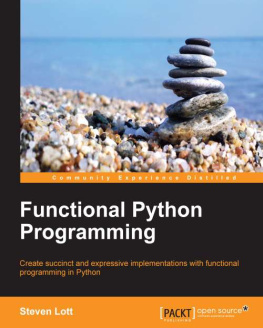Anto Aravinth [Anto Aravinth] - Beginning Functional JavaScript: Functional Programming with JavaScript Using EcmaScript 6
Here you can read online Anto Aravinth [Anto Aravinth] - Beginning Functional JavaScript: Functional Programming with JavaScript Using EcmaScript 6 full text of the book (entire story) in english for free. Download pdf and epub, get meaning, cover and reviews about this ebook. year: 2017, publisher: Apress, genre: Computer. Description of the work, (preface) as well as reviews are available. Best literature library LitArk.com created for fans of good reading and offers a wide selection of genres:
Romance novel
Science fiction
Adventure
Detective
Science
History
Home and family
Prose
Art
Politics
Computer
Non-fiction
Religion
Business
Children
Humor
Choose a favorite category and find really read worthwhile books. Enjoy immersion in the world of imagination, feel the emotions of the characters or learn something new for yourself, make an fascinating discovery.
- Book:Beginning Functional JavaScript: Functional Programming with JavaScript Using EcmaScript 6
- Author:
- Publisher:Apress
- Genre:
- Year:2017
- Rating:5 / 5
- Favourites:Add to favourites
- Your mark:
Beginning Functional JavaScript: Functional Programming with JavaScript Using EcmaScript 6: summary, description and annotation
We offer to read an annotation, description, summary or preface (depends on what the author of the book "Beginning Functional JavaScript: Functional Programming with JavaScript Using EcmaScript 6" wrote himself). If you haven't found the necessary information about the book — write in the comments, we will try to find it.
Learn functional programming concepts using JavaScript ES6. You will learn concepts such as currying, partial functions, higher-order functions, and monads.
Programming languages have evolved from focusing on procedures to objects and now on function. JavaScript supports functional programming and allows developers to write well-crafted code.
What You Will Learn:
- Master functional programming concepts
- Identify how functions are treated in JavaScript
- Understand real-world functional libraries and create a functional library that mimics underscore.js
- Perform pure-error handling techniques such as functors and monads
- Discover ES6 functional features such as spread operators and generators
Who This Book Is For:
JavaScript developers (or beginners) who want to understand functional programming concepts and the functional nature of the language.
Anto Aravinth [Anto Aravinth]: author's other books
Who wrote Beginning Functional JavaScript: Functional Programming with JavaScript Using EcmaScript 6? Find out the surname, the name of the author of the book and a list of all author's works by series.

![Anto Aravinth [Anto Aravinth] Beginning Functional JavaScript: Functional Programming with JavaScript Using EcmaScript 6](/uploads/posts/book/120482/thumbs/anto-aravinth-anto-aravinth-beginning.jpg)









